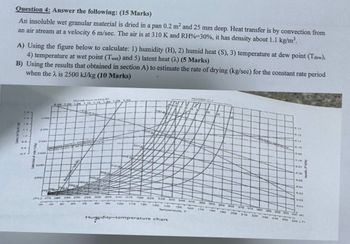
Introductory Circuit Analysis (13th Edition)
13th Edition
ISBN: 9780133923605
Author: Robert L. Boylestad
Publisher: PEARSON
expand_more
expand_more
format_list_bulleted
Question

Transcribed Image Text:Question 4: Answer the following: (15 Marks)
An insoluble wet granular material is dried in a pan 0.2 m² and 25 mm deep. Heat transfer is by convection from
an air stream at a velocity 6 m/sec. The air is at 310 K and RH %-30%, it has density about 1.1 kg/m³.
A) Using the figure below to calculate: 1) humidity (H), 2) humid heat (S), 3) temperature at dew point (Tdew),
4) temperature at wet point (Twet) and 5) latent heat (2) (5 Marks)
B) Using the results that obtained in section A) to estimate the rate of drying (kg/sec) for the constant rate period
when the 2 is 2500 kJ/kg (10 Marks)
jele beau
09
07
Lene of
2420
2400
2330
2300
2250
2200
Hurup This (kg S
05 100 105 1.10 1.18 1.29 1.25
210
TV XL
ST R
9.12
610
890
9.07
80G
shigig
8.00
0.04
9.00
8803
2732 275 260
3040
285 200
295 300
TO
BO
130
140 150 7610
Temperature T
170
310 315 320 325 330 335 340 345 350 355 300 305 306 307 308 305 300 305 400
100 110 120
190 200 210 220 230
240 250 260 4
Hurgidity-temperature chart
Expert Solution
This question has been solved!
Explore an expertly crafted, step-by-step solution for a thorough understanding of key concepts.
Step by stepSolved in 2 steps with 2 images

Knowledge Booster
Similar questions
- .1.1 . Describe the theoretical underpinnings of superconductivity and its potential applications in electrical engineering, highlighting the challenges associated with achieving practical superconducting devices. don't use Al solution either dislikearrow_forwardA 500-turn coil is wound on an iron core. When a 120-V-rms 60-Hz voltage is applied to the coil, the current is 1 A rms. Neglect the resistance of the coil. Determine the reluctance of the core. Given that the cross-sectional area of the core is 5 cm2 and the length is 20 cm, determine the relative permeability of the core material.arrow_forwardA flux of 0.0016 Wb flows in a silicon sheet steel coil/core. The arrangement appears as shown below with the following dimensions: Ac = 0.0025 m? Core/gap area: Flux path length: le = 0.350 m lg = 0.0015 m N = 500 Air gap length: Number of turns: %3D A. What is the current, I, through the winding? B. What is the energy stored in the inductance? C. Assume that the current is given by i =9.75 sin (3147) A. What is the RMS voltage that would appear across the winding? D. Assume that the gap is removed from the arrangement with the flux path remaining at 0.350 m. For a flux of 0.0016 Wb, what is the inductance of the arrangement? E. What is the energy stored in the inductance with the gap removed?arrow_forward
- Where is electrical energy stored in an inductor? O In the electric field surrounding its coils. O In the magnetic field surrounding its coils. O In both the electric and magnetic field surrounding its coils. O An inductor never stores electrical energy.arrow_forwardCompare alternative and direct currents by comparing their physical properties. (Explain alternans, cycles, periods, frequency terms during this comparison. Also in this comparison, explain the electron flow directions separately in alternating and direct current)arrow_forward
arrow_back_ios
arrow_forward_ios
Recommended textbooks for you
 Introductory Circuit Analysis (13th Edition)Electrical EngineeringISBN:9780133923605Author:Robert L. BoylestadPublisher:PEARSON
Introductory Circuit Analysis (13th Edition)Electrical EngineeringISBN:9780133923605Author:Robert L. BoylestadPublisher:PEARSON Delmar's Standard Textbook Of ElectricityElectrical EngineeringISBN:9781337900348Author:Stephen L. HermanPublisher:Cengage Learning
Delmar's Standard Textbook Of ElectricityElectrical EngineeringISBN:9781337900348Author:Stephen L. HermanPublisher:Cengage Learning Programmable Logic ControllersElectrical EngineeringISBN:9780073373843Author:Frank D. PetruzellaPublisher:McGraw-Hill Education
Programmable Logic ControllersElectrical EngineeringISBN:9780073373843Author:Frank D. PetruzellaPublisher:McGraw-Hill Education Fundamentals of Electric CircuitsElectrical EngineeringISBN:9780078028229Author:Charles K Alexander, Matthew SadikuPublisher:McGraw-Hill Education
Fundamentals of Electric CircuitsElectrical EngineeringISBN:9780078028229Author:Charles K Alexander, Matthew SadikuPublisher:McGraw-Hill Education Electric Circuits. (11th Edition)Electrical EngineeringISBN:9780134746968Author:James W. Nilsson, Susan RiedelPublisher:PEARSON
Electric Circuits. (11th Edition)Electrical EngineeringISBN:9780134746968Author:James W. Nilsson, Susan RiedelPublisher:PEARSON Engineering ElectromagneticsElectrical EngineeringISBN:9780078028151Author:Hayt, William H. (william Hart), Jr, BUCK, John A.Publisher:Mcgraw-hill Education,
Engineering ElectromagneticsElectrical EngineeringISBN:9780078028151Author:Hayt, William H. (william Hart), Jr, BUCK, John A.Publisher:Mcgraw-hill Education,

Introductory Circuit Analysis (13th Edition)
Electrical Engineering
ISBN:9780133923605
Author:Robert L. Boylestad
Publisher:PEARSON

Delmar's Standard Textbook Of Electricity
Electrical Engineering
ISBN:9781337900348
Author:Stephen L. Herman
Publisher:Cengage Learning

Programmable Logic Controllers
Electrical Engineering
ISBN:9780073373843
Author:Frank D. Petruzella
Publisher:McGraw-Hill Education

Fundamentals of Electric Circuits
Electrical Engineering
ISBN:9780078028229
Author:Charles K Alexander, Matthew Sadiku
Publisher:McGraw-Hill Education

Electric Circuits. (11th Edition)
Electrical Engineering
ISBN:9780134746968
Author:James W. Nilsson, Susan Riedel
Publisher:PEARSON

Engineering Electromagnetics
Electrical Engineering
ISBN:9780078028151
Author:Hayt, William H. (william Hart), Jr, BUCK, John A.
Publisher:Mcgraw-hill Education,